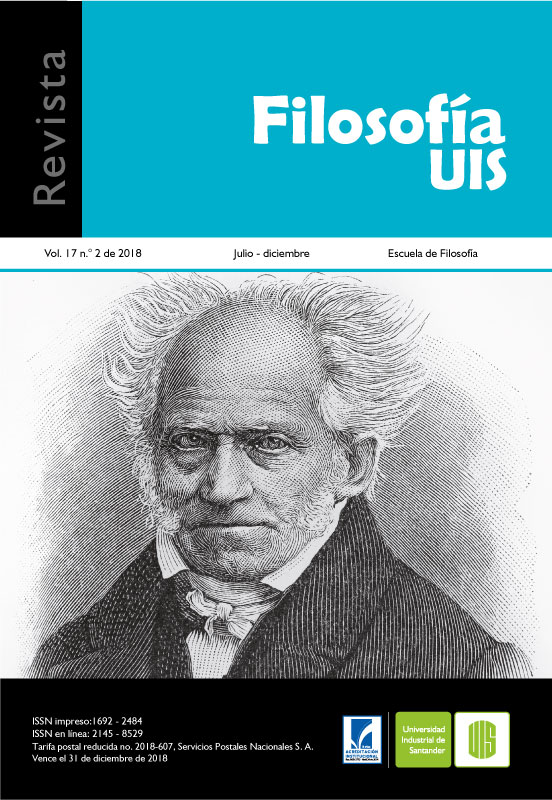The terror of the torture. A phenomenological sketch about its intuitive excess
Published 2018-07-31
Keywords
- terror,
- torture,
- flesh,
- saturation,
- phenomenology
- power ...More
How to Cite
Copyright (c) 2018 Revista Filosofía UIS

This work is licensed under a Creative Commons Attribution 4.0 International License.
Abstract
This paper provides a phenomenological interpretation about how is constituted the terror of the torture from the victim. To that effect I contrast the interpretation about the torture as micro-political power (transcendent perspective) with my proposal of a phenomenological gaze (immanent perspective) about its constitution from the point view of Jean-Luc Marion’s theory of saturated phenomena. The goal is to determine that the terror in the torture depends on intuitive excess of the flesh (chair/Leib) that cannot be contained within the subjectivity of the victim.
Downloads
References
Améry, J. (2001). Más allá de la culpa y la expiación. Tentativas de superación de una víctima de la violencia. Valencia: Pre-textos.
Blair, E. (2010). La política punitiva del cuerpo: “economía del castigo” o mecánica del sufrimiento en Colombia. Estudio Políticos, (36), 39-66.
Das, V. (2008). Lenguaje y cuerpo: transacciones en la construcción del dolor. En F. Ortega. (Ed.), Sujetos del dolor, agentes de dignidad. Bogotá: Universidad Nacional de Colombia.
Foucault, M. (1975). Surveiller et punir. Naissance de la prision. Paris: Gallimard.
Foucault, M. (1992). Microfísica del poder. Madrid: Ediciones la Piqueta.
Foucault, M. (1999). Obras esenciales, Vol. III. Estética, ética y hermenéutica. Barcelona: Paidós.
García, R. (2000). Micropolíticas del cuerpo: Buenos Aires: Biblos.
Henry, M. (2007). Filosofía y fenomenología del cuerpo. Salamanca: Ediciones Sígueme.
Husserl, E. (1997). Ideas II. Ideas relativas a una fenomenología pura y filosofía trascendental. Libro segundo: Investigaciones fenomenológicas sobre la constitución. Ciudad de México: UNAM.
Husserl, E. (2001). Logical investigations. Vol. II. New York: Editorial Matter.
Kant, I. (2006). Crítica de la razón pura. Ciudad de México: Taurus.
Le Breton, D. (1990). Antropología del cuerpo. Buenos Aires: Ediciones Nueva Visión.
Lévinas, E. (1987). Collected philosophical papers. Dordrecht: Martinus Nijhoff Publishers.
Lévinas, E. (1991). Entre Nous. Essais sur le penser-à-l’autre. Paris: Éditions Grasset & Fasquelle.
Lévinas, E. (1999). De la Evasión. Madrid: Arena Libros.
Mackinlay, S. (2010). Interpreting excess. Jean-Luc Marion, saturaded phenomena, and hermeneutics. New York: Fordham University Press.
Marion, J. L. (2002). In excess. Studies of saturaded phenomena. New York: Fordham University Press.
Marion, J. L. (2008a). Siendo dado. Ensayo para una fenomenología de la donación. Madrid: Editorial Síntesis.
Marion, J. L. (2008b). The visible and the revealed. New York: Fordham University Press.
Merleau-Ponty, M. (1976). Phénoménologie de la perception. Paris: Gallimard.
Nahoum-Grappe, V. (2002). Anthropologie de la violence extrême: le crime de profanation. Revue internationale des sciences sociales, (174), 601-609.
Nancy, J-L. (2000). Corpus. Paris: Éditions Métailié.
Richir, M. (1993). Essai sur l’intériorité. Paris: Hatier.
Ricoeur, P. (2004). A l’école de la phénoménologie. Paris: Librarie Philosophique J. Vrin.
Sartre, J. P. (1943). L’être et le néant. Paris: Éditions Gallimard.
Scarry, E. (1985). The body in pain. The making and unmaking of the world. New York: Oxford University Press.
Sofsky, W. (1998). Traité de la violence. Paris: Gallimard.
